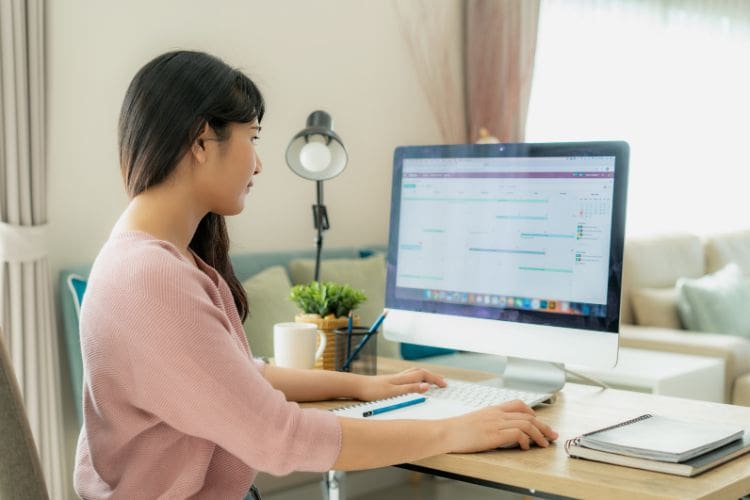Remote work offers flexibility, reduced commute times, and the comfort of working from your own space. Yet, working from home is not without its challenges.
If you’ve felt isolated, demotivated, or stuck in a fog of depression since transitioning to work from home, you’re not alone. The good news is that with a few intentional strategies—and a willingness to seek help when needed—you can protect your mental health while continuing to thrive professionally.
The Hidden Challenges of Remote Work
For people who are already dealing with depression or other mental health challenges, working from home can sometimes magnify certain stressors:
- Isolation. If your job doesn’t allow for daily interactions with coworkers, loneliness can creep in—making the workday feel draining rather than energizing.
- Blurred boundaries. When your office is steps from your living room, it’s easy to lose the separation between work and personal life. Over time, this can lead to burnout—especially if you struggle with time management.
- Reduced routine. For a typical office job, the structure of commuting, set lunch breaks, and clear quitting times provide natural anchors. Without these touchpoints, your day can feel aimless.
How to Work at Home Without Sacrificing Your Mental Health
Having a mental health condition doesn’t necessarily mean you need to forgo remote work entirely. Small but meaningful changes can make a world of difference.
Tip #1: Create Physical and Mental Boundaries
One of the most effective ways to maintain your mental health is by establishing clear boundaries between your work life and home life. Without a physical commute, these boundaries may feel nonexistent—but they’re essential to protect your well-being.
- Designate an office space. Set up a specific area in your home for work. Whether it’s a spare room or a corner of the dining table, having a designated workspace creates a mental association with productivity.
- Dress for success. It’s tempting to work in pajamas, but changing into comfortable but work-appropriate clothing signals to your brain that it’s time to focus.
- Turn your laptop off. At the end of your workday, power down your laptop, tidy up your workspace, and step away. Working at home doesn’t mean you are expected to work 24/7.
Tip #2: Make Social Connection a Priority
Remote work (also called work from home) can sometimes make you feel like you’re living on an island, especially if you don’t have a spouse and children at home. Building intentional connections into your day can combat loneliness.
- Schedule daily check-ins with your team. Even a short video call can provide a sense of camaraderie and accountability.
- Try virtual co-working. Join work from home communities or co-working sessions online. Simply working “alongside” others virtually can reduce feelings of isolation.
- Make time for in-person connections. Whenever possible, plan in-person coffee dates or networking meetups with colleagues or friends.
Tip #3: Plan Time for Self-Care
Creating a routine that includes moments for self-care can help ease feelings of depression and help with your general sense of work-life balance.
- Start a morning ritual. Begin your day with intention. Whether it’s a five-minute meditation, journaling, or stretching, a morning ritual can set a positive tone for the day and reduce feelings of anxiety.
- Schedule workday breaks. Step away from your desk periodically. Take a walk, do a quick workout, or simply sit outside to recharge.
- Plan an evening wind-down. Create an end-of-day routine to transition into relaxation mode. This could include cooking, reading, or engaging in a hobby you love.
Tip #4: Move Your Body
Exercise is a natural mood booster, and incorporating movement into your day can significantly improve your mental health. You don’t need an elaborate fitness routine; even small changes can help.
- Try quick desk stretches. Start with stretches at your desk to release tension in your neck, shoulders, and back.
- Take a short walk. A 10-15 minute walk during lunch or between meetings can refresh your mind and improve your ability to focus.
- Sneak in a home workout. Try yoga, Pilates, or even a quick cardio session from the comfort of your living room. YouTube has easy-to-follow routines for all fitness levels.
Tip #5: Be Gentle With Yourself
If you’re working from home, it’s easy to fall into the trap of self-criticism. You might feel guilty for being less productive on certain days or frustrated by your inability to shake off feelings of sadness.
- Acknowledge your feelings. Depression isn’t a sign of weakness—it’s a valid mental health condition. Give yourself permission to feel without judgment.
- Celebrate small wins. Whether it’s completing a task, making it through a tough day, or simply showing up, take time to acknowledge your efforts.
- Reframe negative thoughts. Instead of thinking, “I’m not doing enough,” try reframing it to, “I’m doing my best today, and that’s enough.”
Tip #6: Seek Professional Support
If you’ve noticed that your home no longer feels like a haven—or if the walls of your workspace seem to close in around you—it’s okay to take a step back and reassess.
At Raleigh Oaks Behavioral Health, we specialize in providing support for individuals navigating depression, anxiety, and other mental health challenges that can be aggravated by workplace stress. We can help you find the right tools and resources to create a work from home experience that nurtures—not depletes—your mental well-being. Reach out today to learn more about the programs at our Garner, North Carolina, mental health treatment center or to schedule a free, confidential assessment.





